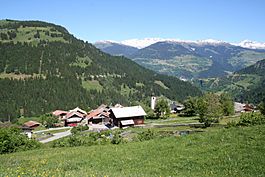Pitasch facts for kids
Quick facts for kids
Pitasch
|
||
|---|---|---|
 |
||
|
||
| Country | Switzerland | |
| Canton | Graubünden | |
| District | Surselva | |
| Area | ||
| • Total | 10.81 km2 (4.17 sq mi) | |
| Elevation | 1,060 m (3,480 ft) | |
| Population
(Dec 2011)
|
||
| • Total | 106 | |
| • Density | 9.81/km2 (25.40/sq mi) | |
| Postal code |
7111
|
|
| Surrounded by | Cumbel, Duvin, Riein, Safien, Sevgein | |
Pitasch is a small, quiet village that used to be its own municipality in Switzerland. It's located in the beautiful Graubünden area, which is a canton (like a state) in the eastern part of Switzerland.
On January 1, 2014, Pitasch joined with several other nearby villages. These included Castrisch, Ilanz, Ladir, Luven, Riein, Ruschein, Schnaus, Sevgein, Duvin, Pigniu, Rueun, and Siat. Together, they formed a bigger municipality called Ilanz/Glion.
Contents
A Glimpse into Pitasch's Past
Pitasch has a long history! It was first mentioned in old writings around the years 801 to 850. Back then, it was called Pictaui. This information comes from a copy made in the 1500s.
Later, in the year 960, it was mentioned again as in Pictaso. These old names show how long people have lived in this area.
Where is Pitasch? Exploring its Location

Pitasch is a small place, covering about 10.8 square kilometers (which is about 4.2 square miles). A big part of this land, about 31.4%, is used for farming. Nearly half of the area, 49.1%, is covered by forests.
Only a small portion, 1.5%, has buildings or roads. The rest of the land, about 18%, includes natural features like rivers or mountains.
The village is located south of Ilanz. It sits on a flat area between two valleys, the Val Renastga and the Val da Pitasch. It's also on an old road that connects Castrisch to Safien.
Who Lives in Pitasch? Understanding its People
As of 2011, Pitasch had a population of 106 people. A small part of the population, about 2.7% in 2008, were people from other countries. Over the last ten years, the number of people living in Pitasch has slightly decreased.
Most people in Pitasch speak Romansh, which is a traditional language of Switzerland. About 60.2% of the population spoke Romansh in 2000. The rest, 39.8%, spoke German.
In the 2007 Swiss federal election, the most popular political party was the SVP. They received 41.3% of the votes. Other popular parties included the FDP and the SP.
Many adults in Pitasch have completed higher education. About 70.1% of people aged 25–64 have finished advanced schooling. This includes either upper secondary education or even university.
Pitasch has a low unemployment rate of 2.05%. In 2005, about 20 people worked in the primary economic sector, which includes farming. There were also 8 businesses in this sector. A few people worked in the tertiary sector, which includes services, with 3 businesses.
Here's how the population of Pitasch has changed over time:
| year | population |
|---|---|
| 1850 | 96 |
| 1900 | 105 |
| 1950 | 125 |
| 2000 | 118 |
Exploring Pitasch's Historic Church
The Swiss Reformed Church building in Pitasch is very important. It is listed as a heritage site of national significance in Switzerland. This means it's a special place worth protecting.
The church was built in the mid-1100s and has a simple design. It has a single main room (called a nave) and a rounded end (called an apse). Inside, you can see beautiful murals (wall paintings) that were created around 1420.
On the outside, on the south wall, there's another mural. It shows St. Martin and St. Christopher. This painting was made around 1340 by an artist known as the Waltensburg Master.
See also
 In Spanish: Pitasch para niños
In Spanish: Pitasch para niños







